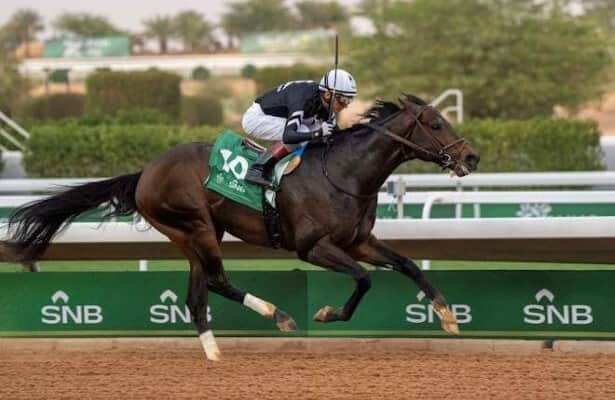Indian Relay races connect Horse Nations tribe riders with

Indian Relay, a race where riders risk collisions with thousand-pound horses, is both exhilarating and dangerous, but team manager Mason Red Wing says the connection with horses saved his life.
Red Wing grew up on the Crow Creek Sioux Reservation in South Dakota, angry at his own people. Native American communities suffer from high rates of substance abuse and Red Wing’s own father succumbed to alcoholism. The horses Red Wing’s team brings to Indian Relay races reconnected him with his culture and made him feel proud of who he is and where he’s from.
“What the horse done for me, I know the horse can do that for everyone 1,000 times over,” he said. “And I’m a firm believer in it. I know for a fact it can, it can bring our young men and our young women back.”
What is Indian Relay?
Members of the Shoshone, Crow, Blackfeet, Sioux and other tribes of the Great Plains — collectively known as the Horse Nations — have relied on horses for hunting, battle and survival for centuries. Men, women and children from those tribes also use horses in a sport that fans have dubbed “America’s original extreme sport.”
During Indian Relay, as many as six thoroughbred racehorses are brought to a start line drawn in the dirt. They’re bareback — no saddles, no stirrups.
60 Minutes
The riders, who don’t wear any protective gear, leap aboard their horses and tear down the track at the sound of a horn. As the racers finish the first lap around the half-mile track, teammates are waiting with fresh horses for what’s known as the exchange.
Riders leap from their horsebacks, jump onto the fresh horses and speed off for a second lap. Their teammates need to wrangle the speeding horses who’ve just finished the first lap. Then the riders and their teammates repeat the process again for the third and final lap. The exchange can involve six riders, 18 horses, 18 other humans and a cloud of dust kicked up by the racing.
The exchange is dangerous not just for the riders but also for their waiting teammates. Injuries to people and horses are part of the sport, said Ken Real Bird, who announces races.
“Almost every heat will have some of the guys getting run over,” Real Bird said.
There are just two laps in the women’s division of Indian Relay. In the kids’ division, with riders as young as 6, children race on ponies for three laps around a much shorter course.
Where did the sport come from?
The roots of modern Indian Relay are in the horse-stealing raids that tribes once staged against White settlers and each other, Real Bird said.
“When it was [the] middle of the night, they would come and take the prize horse and high-tail it back to their home country,” Real Bird said. “They exchanged horses as they were running, because they were being pursued. And so that’s pretty much the origin of the Indian Relay sport that we know today.”
Races in the organized sport were first conducted in the early 1900s.
“[It’s] how we connect to the warriors of the past, the warriors of 200 years ago,” Real Bird said. “It’s that same bloodline of that warrior that is coursing through their blood.”
60 Minutes
When they first started out, most of the races were happening on reservations and in Native American communities, according to Calvin Ghost Bear, president of the Horse Nations Indian Relay Council.
“What we do with Horse Nations is we basically took a lot of the races that were within the tribal nations, brought them out into the mainstream,” Ghost Bear, a member of the Sioux Tribe, said. “And now, we’re bringing it onto a bigger stage.
Indian Relay today
Last summer’s Indian Relay circuit around the West climaxed in Casper, Wyoming, with a three-day championship event that celebrated tribal culture in song, drum and dance. More than $100,000 in prize money was up for grabs, thanks to sponsorship from a casino owned by the Northern Arapahoe tribe.
There’s little glamor in Indian Relay, and lots of hard work. Every team is self-funded and nearly everyone involved has a day job to help pay the bills, but the sport is on the rise. The amount of prize money and the number of participants are both growing; 67 teams competed in last summer’s championships.
The quality of their horses is rising too. Teams go to major racetracks to buy — and then breed — thoroughbred speed horses well-suited to the Indian Relay format.
Ghost Bear dreams of bringing Indian Relay to Churchill Downs, home of the Kentucky Derby.
“Kentucky, that would be the ultimate, ” Ghost Bear said. “A demonstration race before the Derby, that would be, that would be my goal.”
Related
Saudi undercard: Straight No Chaser wins 1 of 5 graded…
Straight No Chaser arrived from America with the billing as one of the major equine attractions of this year’s Saudi Cup meeting. He duly dazzled in the Grou
American Reporter Snubs Kentucky Derby and California for Non-USA Horse…
Do you recall when Mike Repole gave an early warning to the American horse racing industry? The American businessman remarked, “You’re not a national sport
Saudi Cup Top Contenders: RATTLE N ROLL
In the days leading up to Saturday’s $20 million Saudi Cup at King Abdulaziz Racecourse in Riyadh, usracing.com is posting profiles of the leading cont
Saudi Cup: Forever Young Draws Outside, Romantic Warrior Inside
For a horse race billed as the richest in the world, there sure doesn’t seem to be much buzz around the $20 million Saudi Cup (G1) in Riyadh, Saudi Ara
















